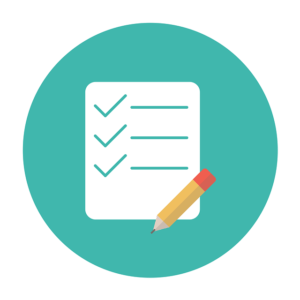A Lazy Girl’s guide to landing page copy that woos web visitors
Tut-tut.
Conversion rate optimization. A/B testing. Heatmaps. Writing copy that converts.
Do we really need to?
As a business owner, you have a lot of other things to do.
Yep, of course you’d like more email subscribers. More sales. More business.
But keeping up with the advice is overwhelming. Let alone trying to implement it.
So can we keep it simple?
Let’s have a look …
Table of Contents
What’s landing page copy?
A landing page entices web visitors to take a specific action – to subscribe to a newsletter, to download a report, or to buy a product.
Would you like to see an example?
Check out my landing page to sign up guest post readers to my email list, or the new sales page for my Enchanting Business Blogging e-course.
The lazy girl’s most important landing page tip
You know people get easily distracted, don’t you?
And you know that when you present choices, people procrastinate because they can’t make up their minds?
That’s why you need to remove all distractions.
Your landing page should have no navigation menu and no side-bar with tempting links to other places.
When you give people the option to browse your site, they start wandering around. They start hesitating whether to buy your orange or purple-dotted scarf. They forget to sign up to receive your juicy bonus.
To tempt people to take your preferred action, you need to hold their gaze. You need to remove distractions and tell them exactly what to do.
Start at the end
Starting at the end means you define the required action first.
Subtleties and politeness are great. But not for calls-to-action. Be bossy. Start with a verb. For instance:
- Order now
- Sign up for a free trial
- Download your ebook
You might think a lazy girl is after instant gratification and that’s why she starts at the end.
But starting at the end keeps you on track when writing your copy. You discount all ideas that don’t contribute to taking that action. You write your copy faster. And you avoid vague actions like submit or next.
Persuade people to take action
Even when you give an ebook away, you still need to “sell” it.
An abundance of free information is available online. Inboxes are overflowing. Why would people give up their email address and spend their precious time reading your ebook?
Tell people exactly why they should give up their time or money:
- Step into the shoes of your reader
- Write down how your product or ebook will help him
- Consider what’s stopping him from taking action and how you can overcome these obstacles
As business owners, we tend to focus on what we offer (a free 20-page report!) rather than how a reader will benefit from reading that report (21 tips to save money when shopping online). This is the biggest mistake you can make when writing landing pages copy.
The legendary copywriter John Caples said in his book Tested Advertising Methods:
“The most frequent reason for unsuccessful advertising is advertisers who are so full of their own accomplishments (the world’s best seed!) that they forget to tell us why we should buy (the world’s best lawn!).”
Your readers aren’t interested in your report, your product, or your free trial. They want to know what’s in it for them.
So how do you get your readers to take action? How do you avoid this most common mistake?
Follow these 3 simple steps to planning landing page copy:
- Create a list of benefits. If you struggle with defining benefits, list features first, and then ask yourself So what? Why does my reader care?
- Create a list of objections to taking the required action. What might stop people to download your report, sign up for your free trial, or buy your product?
- List the benefits and objections in order of importance; mention the most important information first.
Don’t make life too difficult. If you’re “selling” a free report, you don’t list as much information as when you sell an expensive product or e-course. My email subscription page is far shorter than my e-course landing page.
A lazy girl knows better than anyone else that the more you write, the sooner you bore your web visitors to death. And bored people click away (or fall asleep!) rather than download your report or buy your course.
This is usability expert Steve Krug’s advice on editing (from his book Don’t Make Me Think):
“Get rid of half the words on each page, then get rid of half of what’s left.”
Measure your success and improve results
A lazy girl is less lazy when she knows her efforts are paying off.
When you make an effort to create a landing page, you want to know your time is well spent. In Google Analytics, set up a goal to measure how many conversions you get:
- Go to Admin at the top of your Google Analytics dashboard
- Under the section View, select Goals
- Click the red New goal button
- Select Custom, click Next step, and give your goal a name, e.g.download report, and select your type of goal – in most cases this is a destination
- Click Next step and enter the URL that people will reach once they’ve completed the conversion – usually you have a Thank you page that people will reach after they’ve signed-up for your newsletter or free trial, or after they’ve purchased your product.
- Click Create goal.
Conversion experts will tell you to create a separate landing page for each source of traffic. But that’s a lot of work. The lazy girl’s method is to have just one page and learn which traffic converts worst. She simply creates a new landing page for the worst-converting traffic.
I noticed, for instance, that my traffic from KISSmetrics converted much better than traffic from Copyblogger. That’s given me an incentive to set upa new landing page targeted at Copyblogger readers. This doubled conversions from Copyblogger already.
When you start, keep things simple. Write as few words as possible. Create one landing page. And then build on the work you’ve done.
Treat web visitors like people
Sales gurus may tell you to use exclamation marks and yellow highlighters on your landing page.
Conversion experts may tell you to have bigger buttons and to make them green, and to use huuuuge pop-up forms to obscure your content.
But don’t forget your web visitors are people. They’re not numbers.
Be human and interact with people almost like you would in real life.
Be firm, but don’t hide your own unique voice. Be yourself.
 About the writer: Henneke Duistermaat
About the writer: Henneke Duistermaat
Henneke Duistermaat is an irreverent copywriter and marketer. She’s on a mission to stamp out gobbledygook and to make boring business blogs sparkle. Get her free 16-Part Snackable Writing Course for Busy People and learn how to enchant your readers and win more business.



